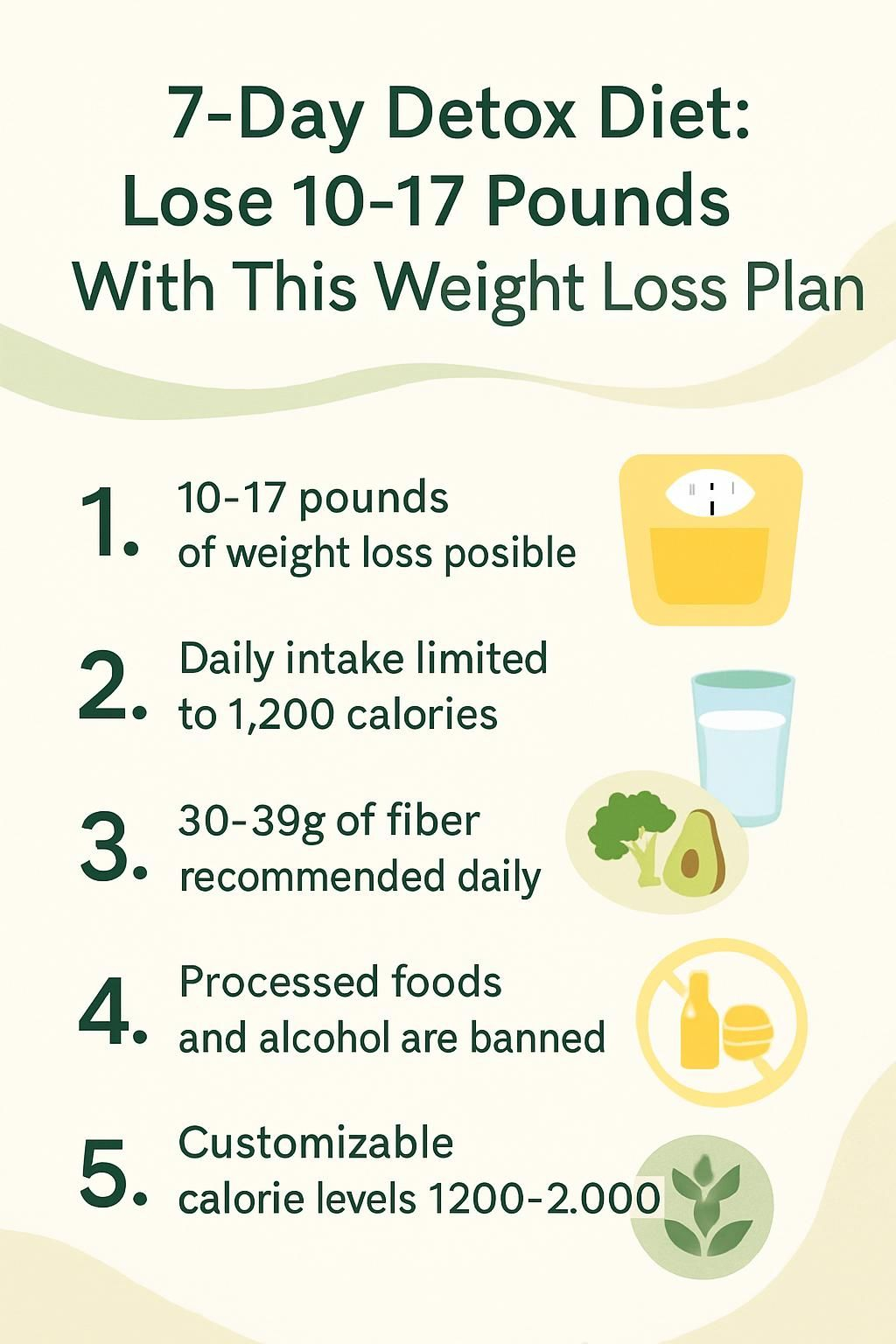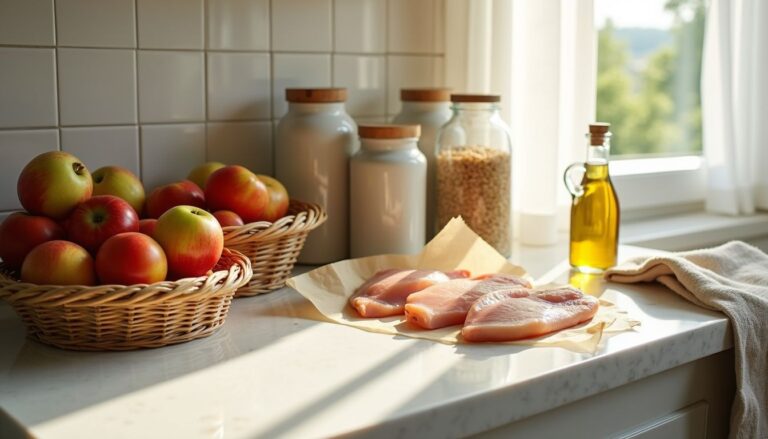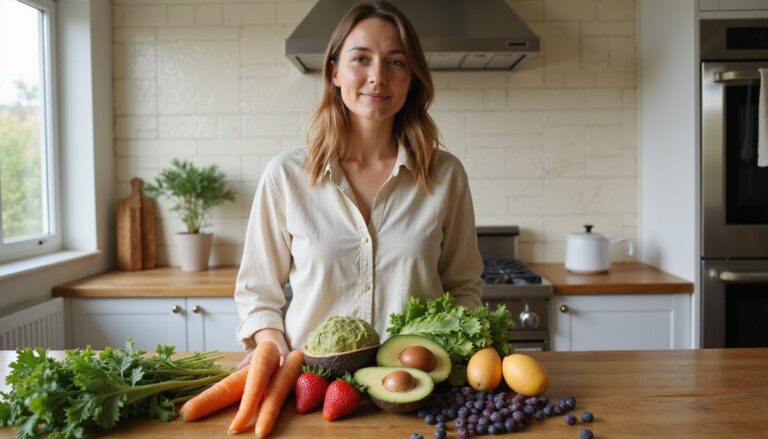7-Day Detox Diet: Lose 10-17 Pounds With This Weight Loss Plan
Our Nutrition Assistant AI Suite will transform your body. You will lose fat, get toned, and build muscle. Gain confidence and optimal health.
You may feel tired, puffy, or stuck because your current routine is not helping you lose weight. A 7-day detox diet, used as a short reset, can help you cut calories and refocus on whole foods. This weight loss plan aims to help you lose weight quickly while teaching habits you can keep.
Inside, you get a step by step guide to support your metabolism, the set of processes that turn food into energy. You will see simple meals, nutrition tips, and practical advice based on research. The goal is a clean start with fewer cravings and a clear path forward.
If you are ready for a focused week and a fresh plan, start here.
Key Takeaways
- The 7-day detox diet often targets about 1,200 calories per day. Some plans claim 10 to 17 pounds lost in a week, while the National Institutes of Health advises a safer pace of 1 to 2 pounds per week.
- Meals center on fruits, vegetables, lean proteins, whole grains, healthy fats, and probiotic foods. You skip ultra processed foods, refined sugars, alcohol, and fried items, an approach supported in recent research and guidance from Harvard Health Publishing.
- Fiber intake around 30 to 39 grams per day and steady hydration with water or herbal tea can improve digestion and reduce bloating.
- People often report clearer skin, better energy, and improved sleep within seven days after cutting inflammatory foods and eating antioxidant rich produce.
- Calorie levels can be adjusted to 1,200, 1,500, or 2,000 per day. Plans reviewed by credentialed dietitians help keep meals balanced and flexible.

What is a 7-Day Detox Diet?

A 7-day detox diet is a short plan that promotes rapid weight loss. Some versions claim you could lose 10 to 17 pounds in one week, though that pace is faster than most experts recommend. It is popular as a kick start that helps you refocus on quality foods and hydration.
You emphasize unprocessed fruits and vegetables, salads, and plenty of water or herbal tea. Processed foods, added sugar, and alcohol come off your plate. Some versions, including TV doctor plans, allow unlimited non starchy vegetables and suggest a nonalcoholic drink for social events.
The idea is to support your body’s natural detoxification, the way your liver and kidneys clear waste. Instead of fasting, you follow firm food choices like smoothies, soups, and clean whole foods at each meal. Many people eat within an 8 AM to 8 PM window to reduce late night snacking.
This kind of 7-day diet can give your digestion a break and may lower water weight. People often use it as a reset before returning to a more sustainable pattern.
How does a 7-Day Detox Diet work?
The plan typically sets calories near 1,200 per day to create a calorie deficit. Meals focus on high protein and high fiber foods like eggs, low fat yogurt, poultry, fish, avocado, quinoa, nuts, and leafy greens. Removing simple carbs such as white flour and added sugar can help control hunger.
Snack freely on non starchy, low glycemic vegetables, including celery, cucumber, tomatoes, and asparagus. Keep eating within a 12 hour window from 8 AM to 8 PM. Start mornings with hot lemon water, then choose coffee or green tea, and have a fruit or vegetable smoothie for breakfast.
Meal prep keeps things easy. Make oatmeal cups, roast a tray of vegetables, and hard boil eggs. A basic multivitamin and vitamin D can help fill gaps if your intake is low. During my own week on a similar plan, having ready snacks like carrots and eggs helped curb cravings.
Benefits of a 7-Day Detox Diet
A well planned detox week can improve energy, digestion, and confidence. Think of it as a short test drive for better habits.
How does a detox diet improve digestion?
Eating 30 to 39 grams of fiber daily supports regularity and gut health. Vegetables, legumes, and whole grains help form soft, bulky stools that move more easily. That means less bloating and more comfort.
The plan includes prebiotic foods that feed good bacteria and probiotic options like Greek yogurt that add helpful microbes. Drinking water and herbal teas keeps waste moving while you stay hydrated. Cutting processed foods and refined sugars further reduces gas and swelling.
Many people notice less stomach upset by day three and feel lighter after meals.
“Eating more fiber from beans and leafy greens made my digestion much better,” a friend told me during her detox cleanse.
Choosing whole, fiber rich foods is a simple way to support regularity all week.
How can a detox diet increase energy levels?
A smart detox plan stabilizes blood sugar with whole grains, lean proteins, and healthy fats. That steadiness helps avoid energy highs and crashes. High fiber options like lentils and brown rice keep you full and fueled.
Hydration matters too. Even mild dehydration can drain energy, so water and herbal tea are part of the plan. Handy snacks such as eggs, nuts, and fruit give a quick lift without added sugars.
Calorie levels can be adjusted to 1,200, 1,500, or 2,000 per day. Matching intake to your needs helps you stay active through the week.
How much weight can you lose with a detox diet?
Some 7-day detox plans claim 10 to 17 pounds lost in a week at about 1,200 calories per day. A popular TV doctor plan promises up to 10 pounds in two weeks. In contrast, the NIH defines safe and typical loss as 1 to 2 pounds per week.
Results vary with metabolism, hydration, and how closely you follow the meal plan. Rapid loss often reflects water weight first. During a strict college cleanse, I lost almost seven pounds in a week, then regained much of it after returning to my old habits.
For lasting results, most health professionals favor a balanced diet with fewer processed foods and steady activity.
How does a detox diet reduce inflammation?
If you are aiming to lose pounds per week, you may also notice less achiness. Many plans reduce inflammation by removing refined carbs, processed foods, and added sugar. That means skipping packaged snacks and sugary drinks that spike blood sugar.
Fruits and vegetables supply antioxidants like vitamin C that help calm your immune response. Healthy fats from olive oil, avocado, almonds, and seeds support your natural defenses. Alcohol and most dairy are limited, except for cultured yogurt, since both can trigger issues for some people.
Evidence supports choosing whole grains over refined grains to lower inflammatory markers. Favor simple cooking methods with olive oil instead of heavy sauces or deep frying. Several small studies suggest people feel less joint pain within days of switching to produce rich meals.
Can a detox diet improve skin health?
Reducing inflammatory foods can help clear your complexion. The plan highlights fruits and vegetables high in antioxidants, such as spinach, apples, and cauliflower, which protect skin from daily damage. Water and herbal tea improve hydration, so skin looks softer and less dry.
Healthy fats from nuts and avocado support the skin barrier. Cutting processed foods, artificial sweeteners, and alcohol may lead to fewer breakouts and less redness. Lowering added sugars also helps limit acne flare ups tied to high blood sugar swings.
Many people notice brighter, smoother skin by day seven if meals stay balanced and water intake stays high.
How does a detox diet enhance mental clarity?
Replacing processed foods and added sugars with produce and proteins can sharpen focus. Antioxidant rich fruits and vegetables support brain health and reduce oxidative stress, which can affect memory and attention.
Balanced meals give steady fuel for your brain across the day. Adequate water intake supports thinking because even mild dehydration slows mental processing. Avoiding alcohol helps your brain work more efficiently during the week.
Many people feel clearer by day three. Better sleep, which often improves during a reset, can enhance focus as well.
Does a detox diet improve sleep quality?
Better mental clarity often goes hand in hand with better sleep. Limiting eating to an 8 to 12 hour window, such as 8 AM to 8 PM, helps curb late night snacking that can disrupt rest.
Skipping alcohol and limiting afternoon caffeine support a healthy sleep cycle. Foods rich in magnesium, like nuts and leafy greens, are linked with improved sleep quality. During my own seven day reset, set meal times and fewer processed foods helped me wind down faster.
These changes may reduce cravings late at night and help you wake up feeling fresher.
Foods to Include in a 7-Day Detox Diet
Whole, nutrient dense foods support natural detoxification and metabolism. Choosing a balanced mix can help reduce bloating while supporting weight loss.
Which vegetables are best for detoxing?
Non starchy vegetables add fiber, volume, and antioxidants for very few calories. Aim for color and variety across the week.
- Leafy greens like spinach and baby spinach are low calorie and rich in antioxidants. They appear in many meals during this plan.
- Cruciferous vegetables, including cauliflower and artichokes, support liver function with helpful plant compounds and deliver fiber.
- Zucchini is versatile and low in starch. Use it in soups, salads, or sheet pan meals with lean protein.
- Tomatoes and cucumbers make great unlimited snacks. Their low carb content helps you eat fewer calories and still feel full.
- Asparagus supports kidney function and acts as a gentle diuretic, which can reduce water retention.
- Celery is a crunchy, hydrating snack with very few calories or carbs.
- Scallions and onions add flavor without additives and provide prebiotic fiber that feeds good gut bacteria.
- Chili peppers contain capsaicin, a compound that may modestly increase calorie burn.
Next, see which fruits pair well with these vegetables during your week.
What fruits should you eat on a detox diet?
Fruits bring natural sweetness and key vitamins. Choose options that deliver fiber and antioxidants without a lot of added sugar.
- Apples help with fullness and digestion. They work well as daily snacks.
- Bananas offer potassium and quick energy. Add to snacks or breakfast bowls.
- Clementines supply vitamin C at a low calorie cost.
- Raspberries provide fiber and antioxidants. Use them in breakfast muesli or as a snack with dark chocolate on Day 7.
- Other berries supply polyphenols that may reduce inflammation.
- Apples and bananas can sweeten meals without refined sugar.
- Eating a mix of fruits supports your weight loss and overall health during the 7-day plan.
Why include whole grains in a detox diet?
Whole grains supply fiber and steady energy, which help control hunger. They also support a healthy gut environment during the week.
- Options like brown rice, quinoa, and whole wheat bread add fiber for regularity and comfort.
- High fiber foods increase fullness, which can reduce cravings and overeating.
- A half cup of cooked brown rice at dinner provides complex carbohydrates for daily activity.
- Including grains with meals such as Chipotle Lime Cauliflower Taco Bowls supports stable energy.
- Whole wheat baguette with Curried Sweet Potato and Peanut Soup adds variety without refined flour.
- Fiber from whole grains feeds healthy gut bacteria and acts as a prebiotic.
- Whole grains may lower the risk of type 2 diabetes thanks to slower blood sugar impact.
- Choosing less processed grains helps both fullness and nutrient intake.
- Brown rice absorbs flavors from spices like black pepper, cumin, or garlic during cooking.
- Include at least one serving of whole grains at meals to balance proteins, vegetables, and healthy fats.
What are good lean animal protein options?
Lean proteins help preserve muscle while you eat fewer calories. They also increase fullness and support recovery.
- Skinless chicken breast or turkey provide quality protein with little fat.
- Fish like salmon, cod, or tilapia fit well. Salmon adds omega 3 fats that support heart health.
- Eggs are budget friendly and versatile. Hard boiled eggs are great snacks.
- Low fat Greek yogurt supplies protein and calcium, useful if you exercise.
- Try Sheet Pan Chicken Fajita Bowls on Day 1 for a clean, filling dinner.
- Enjoy Easy Salmon Cakes over baby spinach for variety and helpful fats.
- “Egg in a Hole” Peppers with Avocado Salsa makes a bright, satisfying breakfast on Day 7.
Which beans and legumes support detoxing?
Beans and legumes deliver fiber, protein, and prebiotics. They help control appetite and support gut health during your detox.
- Chickpeas offer protein and fiber. Zucchini Chickpea Veggie Burgers with Tahini Ranch Sauce are a fit for Day 2.
- Lentils steady blood sugar and support gut health. Curried Sweet Potato and Peanut Soup pairs well with lentils or beans.
- Black beans contain antioxidants and prebiotics. Use them in salads or soups.
- Kidney beans provide resistant starch that promotes fullness.
- Navy beans supply soluble fiber that supports heart health.
- Pinto beans are rich in magnesium, a mineral involved in energy production.
- Peas add vitamins A and K plus plant protein. Eat them fresh or blend into dips.
When I tried a 7-day reset last year, adding more legumes helped manage hunger better than relying only on animal proteins. That change made the plan easier to follow.
What are healthy fats for a detox diet?
Healthy fats improve satiety and help absorb fat soluble vitamins like A, D, E, and K. The right choices support both heart and gut health.
- Add one quarter avocado at lunch if you need more calories. Avocados provide monounsaturated fats that may lower LDL cholesterol.
- Cook with olive oil or use it in dressings to aid vitamin absorption and support digestion.
- Snack on one ounce of unsalted roasted almonds for a mix of healthy fat, protein, and fiber.
- Use a tablespoon of natural peanut butter for flavor and lasting fullness.
- Add olives to meals like Spinach Ravioli with Artichokes and Olives for vitamin E and antioxidants.
- Choose nuts such as almonds, walnuts, or pecans for plant omega 3s that help reduce inflammation.
- Replacing processed snacks with a handful of nuts helped me control cravings and keep energy steady through the afternoon.
These fats support digestion, energy, and satiety without relying on heavy sauces or deep frying.
Which probiotic-rich foods help detox?
Probiotics are live bacteria that support a healthy gut. Adding them can improve digestion and nutrient absorption during your 7-day plan.
- Greek yogurt with live cultures like Lactobacillus and Bifidobacterium supports gut balance. Use it as a snack or breakfast.
- Kefir is a fermented milk drink with several probiotic strains. It also provides protein and calcium.
- Sauerkraut offers probiotics and fiber from fermented cabbage.
- Kimchi, a spicy fermented mix, supports gut health and may reduce inflammation.
- Miso, a paste from fermented soybeans, brings flavor and probiotic benefits to soups.
- Naturally fermented pickles, not vinegar pickles, add good bacteria without refined sugar.
- Tempeh is fermented whole soy that delivers both probiotics and protein for plant based meals.
- Kombucha is a tea with live cultures. Pick low sugar versions to stay on track.
Use one or more probiotic foods each day to support digestion throughout the week.
What are the best prebiotic fiber foods?
Prebiotics are fibers that feed your good gut bacteria. They help the microbiome thrive, which supports digestion and may aid weight loss.
- Apples supply pectin, a soluble fiber that supports gut health. Eat them raw or in salads.
- Bananas, especially slightly green, contain resistant starch that feeds gut bacteria.
- Brown rice provides prebiotic fiber and steady energy for daily tasks.
- Whole wheat baguette offers slow digesting carbs and prebiotic fiber. Pair with mustard for flavor.
- Onions contain inulin, a prebiotic that supports digestive balance.
- Garlic offers fructooligosaccharides that encourage growth of good bacteria.
- Asparagus supplies inulin and works steamed, roasted, or chilled in salads.
- Oats are high in fiber and support heart health. Overnight oats with fruit make an easy breakfast.
- Lentils provide protein and resistant starch, ideal for soups like Curried Sweet Potato and Peanut Soup.
During my own weeklong reset, I built meals around apples, brown rice, bananas, and lentil soup. Those choices kept me full while staying regular.
Consult a healthcare professional if you have health conditions or special nutrition needs before trying a detox plan.
What healthy sweeteners can you use?
Natural sweeteners help you skip refined sugar while still enjoying flavor. Use them in small amounts to stay within your calorie goal.
- Bananas add sweetness to smoothies and oatmeal while providing potassium and fiber.
- Apples bring gentle sweetness to snacks and salads with vitamin C.
- Berries sweeten yogurt or breakfast bowls with fewer calories and more antioxidants.
- Raw honey works in tea or dressings. It contains enzymes, but use sparingly.
- Pure maple syrup has trace minerals. Keep portions small.
- Dark chocolate, one ounce with at least 70 percent cacao, offers antioxidants with less added sugar.
- Dates naturally sweeten energy bites or sauces and add fiber and minerals.
Choosing simple sweeteners supports your plan while keeping cravings in check.
Foods to Avoid During a Detox Diet
Skipping certain foods can improve your results. Removing these items makes room for the foods that help you feel and function better.
Why avoid processed foods during detox?
Ultra processed foods often include additives, preservatives, and artificial colors. A 2024 BMJ study linked higher intake of these foods with negative health outcomes. Many packaged items slow digestion and make you feel sluggish.
During my reset, cutting packaged snacks and ready meals boosted my energy and eased bloating. Whole foods like fruits, vegetables, and lean proteins let your system work more efficiently.
Swapping processed items for simple ingredients is central to this plan.
What are the risks of refined sugars in detox?
Refined sugars drive blood sugar spikes that raise cravings and cause energy crashes. This makes appetite control harder and can add to fat storage. Guidance from Harvard Health Publishing and the Cleveland Clinic notes that added sugars are tied to inflammation and digestive issues.
Use fruit or a small square of dark chocolate instead of white sugar. During my week, avoiding refined sugar helped me focus, sleep better, and feel less bloated. If you have concerns about major diet changes, consult a healthcare professional.
Should you avoid alcohol on a detox diet?
Alcohol is off limits during the 7-day detox diet. It can slow liver function and increase inflammation, which goes against your goals. Some people choose a nonalcoholic drink for social situations.
Skipping alcohol can also improve sleep quality. My energy and skin looked better within days when I paused drinking for a week. If you have questions about alcohol or any part of your plan, ask a healthcare professional.
Why stay away from fried foods during detox?
Fried foods tend to be high in saturated or trans fats that raise inflammation and can hinder weight loss. They also add excess calories, salt, and additives that do not support your goals.
Choose roasted, grilled, or sautéed options with olive oil instead. When I skipped fries and fried chicken during a strict week, I felt satisfied on fewer calories and noticed clearer skin.
Replacing fried dishes with cleaner cooking methods supports both short term results and long term health.
Sample 7-Day Detox Diet Plan
A structured 7-day detox diet plan keeps choices clear and measurable. Some plans claim 10 to 17 pounds lost in a week, though safe guidelines support about 1 to 2 pounds per week for most people.
What does Day 1 look like with fruits and vegetables?
Day 1 highlights fruits and vegetables to set up a lighter, fiber rich week. Simple meals keep sodium modest and hunger in check.
- Breakfast: Baked Banana Nut Oatmeal Cup and one medium apple. About 271 calories with fiber and natural sweetness.
- Morning snack: One clementine. About 35 calories and a dose of vitamin C.
- Lunch: Veggie and Hummus Sandwich with fresh vegetables for plant protein and healthy carbs. About 325 calories.
- Afternoon snack: One medium banana. About 105 calories and potassium.
- Dinner: Sheet Pan Chicken Fajita Bowls with half a cup cooked brown rice. Lean protein, peppers, and onions for about 468 calories.
- Daily total: About 1,203 calories, 66 g protein, 177 g carbs, 34 g fiber, 32 g fat, and 1,186 mg sodium.
- Prep tip: Make oatmeal cups ahead for Days 1 to 3. Freeze extras for fast mornings.
- Personal note: I felt more energy and less bloating on Day 1 when I stuck to whole foods and skipped packaged snacks.
How to add whole grains and lean protein on Day 2?
Day 2 adds whole grains and lean protein for steady energy. These foods help control appetite while you stay within your target calories.
- Use cooked quinoa or brown rice at lunch with vegetables for fiber and minerals.
- Midday meal: Chipotle Lime Cauliflower Taco Bowls at about 344 calories, with whole grains and plant protein.
- Morning snack: Add a hard boiled egg. Pair with one ounce Cheddar for about 192 calories combined.
- Dinner: Zucchini Chickpea Veggie Burgers for more fiber and protein.
- Daily target: Around 1,215 calories, with attention to carbs, sodium, and healthy fats.
- Prep tip: Store bowls in airtight containers for quick meals through Days 2 to 5.
- Personal note: Clear calorie goals helped me stay consistent without feeling deprived.
How to include healthy fats and legumes on Day 3?
Day 3 brings in healthy fats and legumes to improve satiety and digestion. This balance supports steady progress without hunger spikes.
- Add chickpeas to lunch or snacks for plant protein and fiber.
- Use avocado on whole wheat toast or in salads for monounsaturated fats.
- Dinner idea: Grilled salmon over spinach. The Easy Salmon Cakes meal is about 401 calories.
- Toss walnuts or almonds into breakfast oatmeal or a snack.
- Make a simple bean soup with black beans or lentils for extra fiber.
- Drizzle olive oil over roasted vegetables instead of heavy sauces.
- Pair hummus with raw vegetables as a filling snack between meals.
- Daily total: Around 1,190 calories including about 36 g fat, similar to the sample plan.
What probiotic-rich foods to eat on Day 4?
Day 4 centers on gut health. Probiotic foods add helpful bacteria that support digestion and may lower inflammation.
- Greek yogurt at breakfast or as a snack for live cultures.
- Kefir as a fermented dairy drink for variety and protein.
- Sauerkraut or kimchi with lunch or dinner for fermented vegetables.
- Kombucha as an afternoon beverage with live cultures. Choose low sugar types.
- Miso in a light soup or dressing.
- Tempeh for a plant forward protein with probiotic benefits.
- Cottage cheese with live cultures as an easy snack.
Eating Greek yogurt each morning kept me full longer and supported digestion throughout the week.
How to increase fiber with prebiotic foods on Day 5?
Day 5 boosts fiber intake with prebiotic foods that feed good gut bacteria. These choices support regularity and better comfort.
- Artichokes for a strong fiber lift, about 7 grams per medium artichoke.
- Oats or barley for prebiotic fibers and steady energy.
- Bananas in snacks for easy prebiotics and about 3 grams of fiber.
- Beans or lentils in meals for soluble fiber and fullness.
- Almonds for an added fiber boost in a small portion.
- Lunch idea: Chipotle Lime Cauliflower Taco Bowls at about 344 calories.
- Dinner idea: Spinach Ravioli with Artichokes and Olives at about 454 calories.
- Daily totals: About 1,220 calories, 51 g protein, 161 g carbs, 39 g fiber, 49 g fat, 1,478 mg sodium.
Next, hydration strategies can help you finish strong.
What hydration and herbal teas are best on Day 6?
Staying hydrated supports digestion and helps flush waste products. Water and herbal teas can also ease cravings as the week wraps up.
- Drink at least eight 8 ounce glasses of water across the day.
- Choose unsweetened herbal teas like ginger, peppermint, or chamomile to calm the stomach.
- Use green tea for antioxidants that may support metabolism.
- Try dandelion tea to support the liver and act as a gentle diuretic.
- Drink hibiscus tea for a tart, refreshing option without added sugar.
- Skip refined sugars in drinks. If needed, use a small amount of stevia or monk fruit.
- Spread fluids evenly through the day rather than all at once.
- Add warm lemon water after meals to support digestion.
- Track your fluids with an app or simple journal to hit your goal.
- Drinking more herbal tea kept me full between meals and cut late night snacking during my week.
How to eat light meals to reset digestion on Day 7?
Day 7 focuses on gentle meals that are easy to digest. This lighter day can help your system transition after a focused week.
- Breakfast: “Egg in a Hole” Peppers with Avocado Salsa, about 285 calories with vitamins, fiber, and healthy fats.
- Lunch: Curried Sweet Potato and Peanut Soup, about 345 calories with complex carbs and plant protein.
- Snack: One cup raspberries with one ounce dark chocolate, about 220 calories with antioxidants and fiber.
- Dinner: Spinach and Artichoke Dip Pasta, about 371 calories per serving.
- Daily intake: Around 1,221 calories, including 47 g protein, 139 g carbs, and 32 g fiber.
- Drink water throughout the day to support bowel movements and waste removal.
- Choose small portions every few hours to reduce stress on your gut.
- Use whole foods like fruits, vegetables, whole grains, eggs or legumes, and avocado for balance.
- Avoid spicy or fried foods that may irritate your stomach.
- Ginger or peppermint tea between meals can soothe digestion for many people.
Light, simple meals today set you up for a smooth shift back to your usual routine.
Tips for Success on a Detox Diet
Small habits make a big difference during a 7-day detox diet. These tips help you follow the plan and feel better while you do it.
Why is drinking plenty of water important?
Water supports kidney function and regular bowel movements, which are key during a reset. Many people notice clearer skin and better energy when they drink 8 to 10 cups per day. Herbal teas add fluids and antioxidants without added sugar.
Hot lemon water in the morning can nudge digestion. Research suggests proper hydration supports metabolism and steady energy during calorie reduced plans. Water also helps you feel full, which can cut cravings.
How can meal prep help your detox success?
Meal prep gives you control over ingredients and portions. Make Baked Banana Nut Oatmeal Cups for Days 1 to 3 and freeze extras. Prep Chipotle Lime Cauliflower Taco Bowls for Days 2 to 5 so lunch is ready without reaching for processed food.
Hard boil a batch of eggs and store them for quick snacks. Planning limits last minute choices that can derail your week. Research shows people who prep meals are more likely to reach their goals because they avoid impulse eating. [1]
[1] https://www.ncbi.nlm.nih.gov/pmc/articles/PMC5372989/
Why should you avoid skipping meals?
Skipping meals can drop your blood sugar, which leads to fatigue and cravings. Regular meals and snacks keep your metabolism steadier and help manage hunger. Claims of losing 10 to 17 pounds per week exist, but steady eating patterns are more realistic and safer.
On days I skipped breakfast during a reset, I felt tired and more likely to overeat later. Once I stuck to planned meal times, my energy improved and my appetite felt easier to manage.
How to manage cravings with healthy snacks?
Plan snacks so hunger does not push you toward processed treats. Choose hard boiled eggs, almonds, Greek yogurt, or fresh fruit for steady energy. Unlimited non starchy vegetables like carrots or cucumbers help fill you up without many calories.
If you want something sweet, try a small piece of dark chocolate with nut butter. In one study, protein rich snacks like Greek yogurt reduced later calorie intake compared to refined carb snacks. Keeping ready to eat options in the fridge makes it easier to stay on track.
Potential Risks and Considerations
A 7-day detox diet is not right for everyone. Review these risks and talk with a healthcare professional if you have any concerns.
Who should avoid detox diets?
People with diabetes, kidney disease, heart problems, or a history of disordered eating should avoid strict detox plans. Low calorie and restrictive routines can raise health risks in these situations.
Speak with your clinician before starting any 7-day detox diet. During a short liquid cleanse I tried years ago, I felt lightheaded and weak, which showed me how quickly nutrient gaps can develop.
Consider your medical history and current medications. Safety comes first.
What common side effects should you watch for?
Headaches, fatigue, irritability, and dizziness can show up during rapid weight loss. Hunger may feel stronger until your body adjusts. Some people notice constipation or diarrhea as they switch foods.
Strict limits can also increase food fixation or lead to weight cycling. Rapid loss often returns once old habits resume. Pay attention to your body’s signals and adjust the plan if needed.
FAQs About 7-Day Detox Diets
Here are short answers to common questions to help you plan your week.
Is it safe to detox for 7 days?
A 7-day detox diet may be safe for healthy adults who speak with a healthcare provider first. Rapid weight loss and extreme plans carry risks, especially for people with chronic conditions or a history of eating disorders.
Doctors often see headaches, fatigue, or dizziness during strict diets. Following medical guidance and checking in with your body can lower the chance of problems as you move through the week.
How much weight can you lose on a detox diet?
Many plans advertise 10 to 17 pounds in a week on about 1,200 calories per day, though dietitians usually advise 1 to 2 pounds per week as a safer goal. Rapid loss at first is often water, not just fat.
Progress depends on starting weight, calorie intake, and adherence. Most experts agree that very fast loss is not typical or sustainable for long term health.
Can you exercise during a detox?
Exercise supports weight loss and overall health during a detox, but you may need to adjust intensity. Calorie restriction can lower energy, so pick moderate activities like walking, gentle yoga, or low impact workouts.
If you feel fatigued, cut back or shorten sessions. Hydration and recovery matter even more while your body adapts.
Conclusion
A 7-day detox diet can help you reset habits and focus on whole foods. High protein, high fiber meals keep you full while you lower calories. Reviewed plans from credentialed dietitians aim to keep nutrition balanced.
Many people report more energy, smoother digestion, and clearer skin after a week. Flexible calorie options and steady hydration can make the plan easier to follow. Pair the week with light activity, then transition to a balanced meal plan for sustainable weight management. If you have a medical condition, consult a healthcare professional before you begin.
FAQs
1. How does the 7-day detox diet help with weight loss?
The 7-day detox diet focuses on whole foods, fruits, and vegetables. It limits processed items and added sugars. This approach reduces calorie intake and may lead to losing 10 to 17 pounds in a week, as shown in some clinical studies.
2. What foods are allowed on the 7-day detox diet?
The plan includes leafy greens, berries, lean meats, eggs, and whole grains. It excludes fried foods, sugary drinks, and refined grains. Water and herbal teas are encouraged for hydration.
3. Is the 7-day detox diet safe for everyone?
Most healthy adults can follow this plan for a short period. People with chronic health conditions, pregnant women, and children should consult a healthcare provider before starting. Research suggests rapid weight loss diets may not suit everyone.
4. What results can I expect after finishing the 7-day detox diet?
Many people report feeling lighter and having more energy. Weight loss varies based on starting weight, metabolism, and adherence to the plan. A personal account from a participant showed a reduction of 12 pounds in one week with improved digestion and sleep quality.
Summary:
The 7-day detox diet uses whole foods to promote quick weight loss by reducing calories and cutting processed items. It may not suit all individuals, so medical advice is important before starting. Results depend on several factors, but many experience positive changes in weight and well-being during the week.







